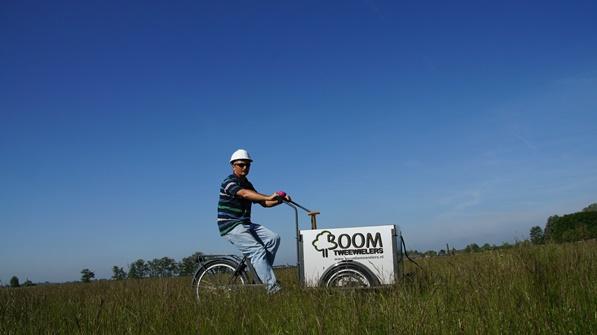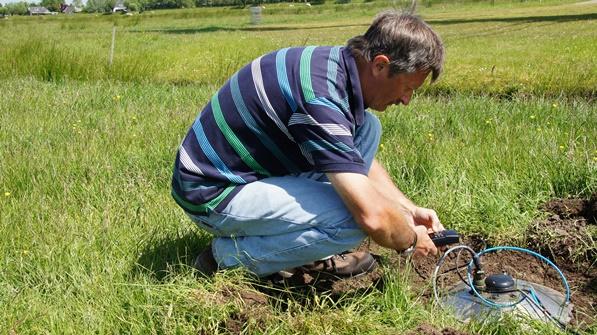

Published on the 3rd June 2014 by ANSTO Staff
 |
| Sylvester Werczynski moved around the Cabauw tower on a three-wheeled pushbike. |
Sylvester Werczynski, from ANSTO’s Institute for Environmental Research, travels to Cabauw in the central part of the Netherlands to measure radon fluxes using a new radon emanometer designed and built at ANSTO.
Radon is an excellent tracer of other gases because it is unreactive and its short half-life (3.8 days) prevents any significant build-up in the atmosphere over long time scales.
The KNMI (Royal Netherlands Meteorological Institute) Cabauw Experimental Site for Atmospheric Research with its 213m meteorological tower has been a focus of experimental boundary layer research since the 1970s.
Over the years, the site has expanded the scope of its research applications to include land-atmosphere interactions. In 2006 and 2007, ANSTO designed and built two 1500L detectors for 222Rn radon observations which were installed on the Cabauw tower, drawing air from 200m and 20m AGL, respectively.
These observations are an important part of a larger program to characterise regional emissions of greenhouse gases and other pollutants, to evaluate the performance of climate and atmospheric transport models, and to quantify turbulent mixing processes in the lower atmosphere.
Radon gas is emitted naturally from soils, where it is formed by radioactive transformation of 226Ra radium as part of the decay chain of primordial 238U uranium in the earth’s crust. The strength of radon emissions from the land surface into the atmosphere depends on the soil mineralogy and porosity, and to a lesser extent also varies with changes in atmospheric pressure and soil moisture.
As the oceanic radon flux is effectively negligible (at least 100 times smaller than that from land), significant radon concentrations measured in air samples indicate that the air mass has been in contact with land within the previous few weeks.
The use of radon as a tracer in atmospheric and climate research is limited by large uncertainties in the magnitude and distribution of the radon flux density over the Earth’s surface. Maps of radon emissions have previously been generated by assigning a constant value to large geographical areas (sometimes reducing at high latitudes according to known changes in snow and ice coverage), or from aerial surveys using terrestrial gamma radiation as a proxy.
The only direct method of measuring radon exhalation from soil is by using an accumulation chamber. Such measurements are rare, and the new ANSTO designed and built radon emanometer has been uniquely designed with this purpose in mind.
The ANSTO portable accumulation chamber allows radon to accumulate in a chamber placed over the soil. The evolution of the measured radon concentration within the chamber is continuously monitored, and the surface flux at that location can then be estimated after a given time period from the integrated measurements.
Equipped with the ANSTO portable emanometer, a shovel, GPS locator, soil type maps of the area and the soil moisture probe, Sylvester Werczynski moved around the Cabauw tower on a three-wheeled pushbike that he hired locally.
“The pushbike was actually the most practical means to access the various measurement locations, as the survey area consisted of a network of flat green polders with thousands of canals, windmills and farm houses - a typical country landscape in the Netherlands,”
says Werczynski.
 |
| Sylvester Werczynski taking radon samples. |
The Cabauw mast itself is located on a polder 0.7 m below sea level, within an agricultural region characterised by grasslands on peaty soil intersected by numerous drainage channels.
Although very picturesque, access using the three-wheeled bike to take a measurement was often difficult, and as a result most of the survey was conducted along bike tracks.
“Fortunately, cycling in the Netherlands is a major transport mode, and the country is covered by a continuous network of cycle paths, clearly signposted, well maintained and well lit, with road path junctions that often give priority to cyclists,” says Werczynski.
Despite various initial obstacles, including heavy rain and strong wind followed by unseasonably hot and sunny weather, the survey was completed successfully and a valuable dataset for climate and air pollution research was obtained.
Learn more about ANSTO’s Atmospheric Mixing and Pollution Transport program (AMPT)